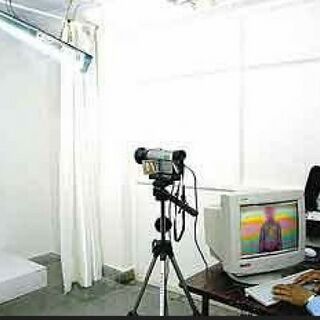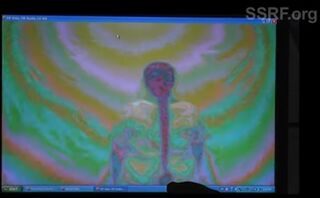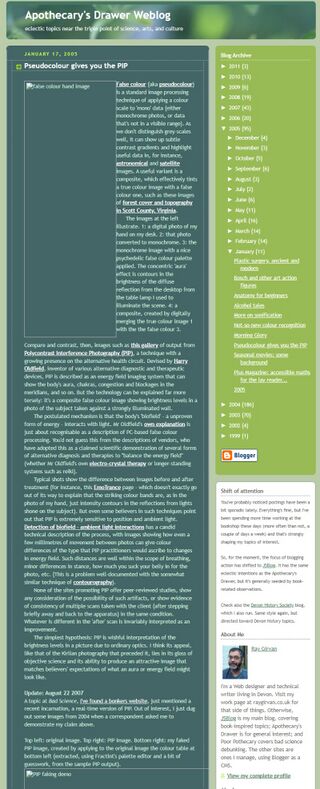Polykontrast-Interferenzfotografie
Die Polykontrast-Interferenzfotografie (engl. polycontrast interference photography, PIP) ist ein ausserwissenschaftlich eingesetztes bildgebendes Verfahren, welches in der Alternativmedizin eingesetzt wird. Erfinder war in den 80er Jahren der Engländer Harry Oldfield (angeblich Biologe, mit verschiedenen fraglichen (schein-)akademischen Titeln). Das Gerät wird regelmässig dazu eingesetzt so genannte feinstoffliche oder "spirituelle" Energien oder Chakren nachzuweisen. So wurde von der neuhinduistischen Gruppe Spiritual Science Research Foundation versucht die spirituelle Energie ihres Gründers und obersten Guru Jayant Bhalaji Athavale mit der Polykontrast-Interferenzfotografie nachzuweisen. Öffentlich im Internet kursierende PIP-Bilder zeigen jedoch völlig unabhängig von Menschen analoge Lichtmuster an Zimmerwänden oder bei profanen Gegenständen aller Art.
Methodik
Zur Methode ist wenig bekannt und Erfinder und Anwender verwenden einen pseudowissenschaftlich Jargon. Eine herkömmliche Videokamera wird mit einem Video- oder Bilddigitalisierer eines Computers verbunden. Erst eine besondere Software (rund 3300 engl. Pfund teuer) berechnet das cherakteristische PIP-Bild, welches als "Falschfarbenbild" auf einem Monitor angezeigt wird.
Funktionsprinzip
Eine überzeugende Erklärung der Polykontrast-Interferenzfotografie kam 2005 von Ray Girvan.[1] (siehe Abbildung). Demnach werden die von einer Kamera gemachten Bilder zunächst nur nach ihren Hellingkeitswerten (in Graustufen) interpretiert. Den einzelnen Graustufenwerten werden dann bestimmte Farbwerte zugeordnet. Da die Wahl der Beleuchtung entscheident ist, und Kameras (eigentlich Objektive) oft am Bildrand niedrigere Helligkeitswrte zeigen, können sich so auf einfache Weise konzentrische Ringe ergeben, die dann in einer gewünschten Weise über eine Person plaziert werden können. Dies ist alleine durch die Wahl der Lichtquelle möglich. Das bedeutet, dass die das Bild aufnehmende Person das PIP-Bild in einer gewünschten Weise gestalten kann.
Eine Gruppe von Autoren aus Slovenien (Robert T. Leskovar, Metod Škarja, Igor Jerman, Bion - Institut Ljubljana, welches ebenfalls "Energien" sichtbar machen will) befasste sich auch mit dem Funktionsprinzip und kommt zum gleichen Ergebnis:
- Polycontrast Interference Photography
Another approach, known as Polycontrast Interference Photography (PIP), was introduced in late 1980s by a British inventor Harry Oldfield. ... The method itself is simple. PIP shows levels of brightness in the picture coded with artificial contrast colours. When a digital camera takes an image, the image includes pixels of various intensities of red (R), green (G) and blue (B) channels, which are combined in a certain real-like colour. Then this method converts RGB colours to grayscale, thus getting indexed palette of 256 shades of gray, with 0 being black and 255 being white. Each pixel has an index, which corresponds to its real brightness value. This palette is then replaced by a prepared palette, which has on same indexes different, artificially designated colours, which are grouped together according to Oldfield's system of correlating levels of brightness with levels of energy balance in organisms.
Although there have been some interesting results shown [ 10 ], this method is quite error prone, since little changes in object's position, ambient light and consequent shading may produce strong changes in resultant colours. Correlating these colours with an "energy balance and well-being" of a person, as his method for interpreting colours suggests, could be in many cases erroneous. It is also not always clear which light bands are results of subtle shades in an ambient and which are results of interaction of the biofield with an ambient light.
Figure 1 shows two images of the same hand with the same ambient lighting conditions. On the second image hand and the whole body were very slightly moved (for a few mm). There was no other change involved. This slight move resulted in change of ambient light bands. There are two sections marked on these images. Upper marked region on the first image could be misinterpreted using Oldfield's system as a health problem area, because of a darker colour area, and the lower marked region could be misinterpreted as an energy field, radiating from fingers. On the second image these regions are different and no conclusions like those from the first image could be made. These changes of person's position were very slight, bigger ones result in even more differences in resultant colours and light bands.[2]
Die neuhinduistisch-neureligiöse Gruppe Spiritual Science Research Foundation SSRF, die sich bei ihren Angaben häufig auf die PIP beruft, lifert folgende Erklärung zum Funktionsprinzip:
- Spiritual Science Research FoundationBei der PIP Technik wird das zu untersuchende Objekt weißem Licht mit einem Spektrum von sieben Farben (Regenbogenspektrum, Vollspektrumlicht) ausgesetzt. Eine spezielle Video-Kamera macht Aufnahmen mit verschiedenen Filtern, die dann mittels einer speziellen PIP-Software analysiert werden. Diese Software lässt Details über das Energiefeld in und um das Objekt herum in Form von Bildern mit verschiedenen Farben und Tönungen erkennen.
Des weiteren werden "Photoneninterferenzen" genannt: PIP benutzt die Software eines PCs mit Videoeingabe und macht ein Scan-Bild der Interferenzen der Energie und des Lichtes.
Es handelt sich daher nicht um eine (objectiv-) neutrale Erfassungsmethode. Die entstandenen Bilder können daher auch als Kunstwerke angesehen werden, und die Untersucher als Künstler.
Siehe auch
- Kirlianfotografie
- Aurafotografie
- GDV
- Konturanalyse (engl. Contour Analysis, moire contourography)[3]
Bilder
zur Glaubhaftmachung eines Elektosmogschutzprodukts
PIP-Bild eines Gurus
Weblinks
- https://skepp.be/nl/apparatuur/pip-polycontrast-interference-photography (in flämischer Sprache)
Quellennachweise
- ↑ Zitat:
Textversion:
Apothecary's Drawer Weblog
eclectic topics near the triple point of science, arts, and culture
JANUARY 17, 2005
Pseudocolour gives you the PIP
false colour hand imageFalse colour (aka pseudocolour) is a standard image processing technique of applying a colour scale to 'mono' data (either monochrome photos, or data that's not in a visible range). As we don't distinguish grey-scales well, it can show up subtle contrast gradients and highlight useful data in, for instance, astronomical and satellite images. A useful variant is a composite, which effectively tints a true colour image with a false colour one, such as these images of forest cover and topography in Scott County, Virginia.
The images at the left illustrate. 1: a digital photo of my hand on my desk. 2: that photo converted to monochrome. 3: the monochrome image with a nice psychedelic false colour palette applied. The concentric 'aura' effect is contours in the brightness of the diffuse reflection from the desktop from the table lamp I used to illuminate the scene. 4: a composite, created by digitally merging the true colour image 1 with the the false colour 3.
Compare and contrast, then, images such as this gallery of output from Polycontrast Interference Photography (PIP), a technique with a growing presence on the alternative health circuit. Devised by Harry Oldfield, inventor of various alternative diagnostic and therapeutic devices, PIP is described as an energy field imaging system that can show the body's aura, chakras, congestion and blockages in the meridians, and so on. But the technology can be explained far more tersely: it's a composite false colour image showing brightness levels in a photo of the subject taken against a strongly illuminated wall.
The postulated mechanism is that the body's 'biofield' - a unproven form of energy - interacts with light. Mr Oldfield's own explanation is just about recognisable as a description of PC-based false colour processing. You'd not guess this from the descriptions of vendors, who have adopted this as a claimed scientific demonstration of several forms of alternative diagnosis and therapies to "balance the energy field" (whether Mr Oldfield's own electro-crystal therapy or longer-standing systems such as reiki).
Typical shots show the difference between images before and after treatment (for instance, this EmoTrance page - which doesn't exactly go out of its way to explain that the striking colour bands are, as in the photo of my hand, just intensity contours in the reflections from lights shone on the subject). But even some believers in such techniques point out that PIP is extremely sensitive to position and ambient light. Detection of biofield - ambient light interactions has a candid technical description of the process, with images showing how even a few millimetres of movement between photos can give colour differences of the type that PIP practitioners would ascribe to changes in energy field. Such distances are well within the scope of breathing, minor differences in stance, how much you suck your belly in for the photo, etc. (This is a problem well-documented with the somewhat similar technique of contourography).
None of the sites promoting PIP offer peer-reviewed studies, show any consideration of the possibility of such artifacts, or show evidence of consistency of multiple scans taken with the client (after stepping briefly away and back to the apparatus) in the same condition. Whatever is different in the 'after' scan is invariably interpreted as an improvement.
The simplest hypothesis: PIP is wishful interpretation of the brightness levels in a picture due to ordinary optics. I think its appeal, like that of the Kirlian photography that preceded it, lies in its gloss of objective science and its ability to produce an attractive image that matches believers' expectations of what an aura or energy field might look like.
Update: August 22 2007
A topic at Bad Science, I've found a bonkers website, just mentioned a recent incarnation, a real-time version of PIP. Out of interest, I just dug out some images from 2004 when a correspondent asked me to demonstrate my claim above.
Top left: original image. Top right: PIP image. Bottom right: my faked PIP image, created by applying to the original image the colour table at bottom left (extracted, using Fractint's palette editor and a bit of guesswork, from the sample PIP output).
PIP faking demo
Posted by Ray Girvan at Monday, January 17, 2005
++++++++++++++++++++++++++++++++
I'm a Web designer and technical writer living in Devon. Visit my work page at raygirvan.co.uk for that side of things. Otherwise, JSBlog is my main blog, covering book-inspired topics; Apothecary's Drawer is for general interest; and Poor Pothecary covers bad science debunking. The other sites are ones I manage, using Blogger as a CMS. - ↑ https://web.archive.org/web/20110910161100/http://www.bion.si/DVB03/detection_biofield_ambient_light_ijs03.htm
mit Beispielbild - ↑ https://web.archive.org/web/20111011143636/http://www.quackwatch.org/01QuackeryRelatedTopics/Tests/contour.html


